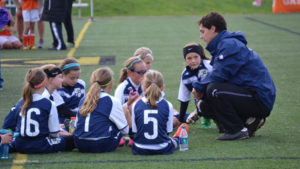Dure: Brainstorming a coaching curriculum for parent coaches
 As a parent coach, I don’t envy the lifestyle of a professional coach — itinerant, subject to the whims of parents with unreasonable expectations, working all through every evening and weekend to get in enough coaching work to make ends meet.
As a parent coach, I don’t envy the lifestyle of a professional coach — itinerant, subject to the whims of parents with unreasonable expectations, working all through every evening and weekend to get in enough coaching work to make ends meet.
I envy one thing about professional coaches: The likelihood of working with motivated kids with a basic understanding of how the sport works, with parents who will usually get them to practices and games on time.
+READ: Dure: Machiavelli’s guide to winning in youth socce
In some cases, parent coaches are better equipped to deal with their kids’ idiosyncrasies. They’re likely to know the kids better than a pro coach would — from school, from the neighborhood, or perhaps from previous seasons. (Side note: That’s one flaw in the AYSO “bust the teams up every season” philosophy. Some players don’t even function outside a comfortable environment, so once that environment is found, why change it?)
But parent coaches also receive absolutely no guidance in dealing with challenging players. The typical licensing or coaching development course is all about drills, often with the parents serving as demonstration guinea pigs. That’s great for recent college grads starting their coaching careers, but for parent coaches, it’s just a heart attack waiting to happen.
So with all that in mind (and tongue partially in cheek), here’s a suggested curriculum for parent coaches:
1. How to teach soccer rules in five minutes or less. We get plenty of kids who have never seen a soccer game. They are baffled by the concept of a kickoff, much less the offside rule.
2. How to explain soccer drills in five minute or less. That’s all the time you’re going to get with the typical group of 8-year-old boys.
+READ: Dure: U.S. youth soccer chaos requires smart choices
3. Advanced shoe-tying. Some of the shoelaces today seem to be made of some complex Teflon that makes them slip out of any knot you can make. I’ve thought about visiting a Boy Scouts meeting to see if I can learn a half-hitch instead of the bow we’re all taught as kids. Sure, it’ll take days for that kid to get his boots off, but it’s better than re-tying those shoes five times a game when you’re trying to coach 12 kids.
 4. Magnetball repellant. If you want to get players to show off skills beyond emerging from a rugby ruck with the ball, you need to get them to spread out. Shouting “Spread out!” doesn’t work. We’ve all tried.
4. Magnetball repellant. If you want to get players to show off skills beyond emerging from a rugby ruck with the ball, you need to get them to spread out. Shouting “Spread out!” doesn’t work. We’ve all tried.
5. Dealing with special-needs kids. A lot of parents resist taking their kids to TOPSoccer, or they simply don’t see the behavioral or physiological problems their kids are exhibiting. Sometimes, the kids aren’t in public schools, and you don’t know whether they’re getting the intervention they need. What do you do as a coach? Are you out of line if you pull a parent aside to point out that running off into the woods making goat horns with his fingers isn’t typical behavior? Or that a player is in obvious distress as he attempts to run?
6. Getting parents to show up. I’ve taken to concealing the game time from my parents and telling them it’s 20 minutes earlier. They still figure it out somehow and show up right at kickoff. Quite a skill. Yet they’re apparently unable to call or text to let you know they’ll be late.
+READ: Dure: If you must cut players, consider the option
7. Letting go of losses. Logically, I know I can’t control results. I don’t recruit players. I’ve helped to develop some good players who have gone on to travel teams, weakening my house teams but better for all in the long run. I take who I get assigned. And I know results don’t matter. But when I’m coaching two teams on losing skids, it’s easy to forget all that.
8. Relaxing. Soccer is an emotional sport. Good things and bad things happen in rapid succession. Some players actually feed on the emotion of their coaches. But more often than not, the coach needs to be the one to set a good example, especially when it comes to negativity. If a coach is pouting or upset, how are players supposed to stay positive?
So we could use a few suggestions for staying calm. Or pharmaceuticals, which might be cheaper than coaching classes.











